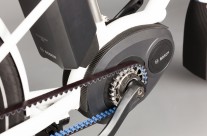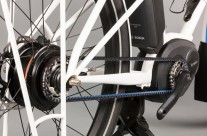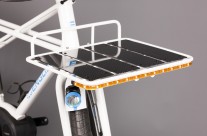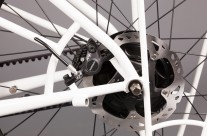No-car-kitty-cargo

This one has been an awful lot of thought in the creating! I first started thinking about the concept a year or so ago. Misha and I have been car free for over four years, and generally we have the bikes to handle most tasks. Misha has an electric assist on her bike to help with the hill when she is carrying a load, and I enjoy the extra training. But we needed a solution to two problems – one is to have a back-up ebike for Misha in case her machine has an issue. The second is that we have one main time when we have to borrow a car – when we have to take one of the cats to the vet. We did put the carrier on the back of the bike one time, but it would be much better for both cat and rider if the animal was loaded on a front rack. So I started thinking about building an e-cargo bike with front and rear racks. A beltdrive is mandatory for any utility bike in Oregon, but that means using an internal hub gear, so rules out using a hub motor. I was just looking at various frame mounted motor options when Gates approached me to do a project with the latest Gen 2 Bosch motor, their Carbondrive and a Nuvinci hub – a perfect match for this concept!
I worked on the design for a while – I settled on 24″ wheels to give the rack height I wanted, with 2.1″ tires for a level of shock absorption. Longer chainstays allow for a large rear rack platform and plenty of pannier space. The front rack is attached to the frame, supported by extended twin toptubes, which are joined to an oversize headtube with an Inset headset, which keeps the front rack as close to the front wheel as possible. The front rack is removable for shipping the bike, or for bolting on a different system if required. The rear rack is integrated into the frame and both racks feature carbon top plates made by Ruckus. With the frame being built very stiff to handle well when loaded, I decided this would be a good place to prototype my titanium flexmast. I have long been a proponent of long titanium seatposts for a degree of flex and thus comfort at the saddle. In order to increase the available flex I added a pivot at the toptube junction, with a titanium tube bolted into sleeves here and above the motor. The pivot runs on two sealed cartridge bearings, bolted in place and capped with machined plastic covers.
Misha and I have an almost identical saddle height, so little adjustment needed there, but my bar position is long and low compared to hers being short and high. I wanted the bike to be quickly and easily adjustable from one to the other, so I designed a parallelogram stem which adjusts with a single bolt whilst maintaining the angle of the handlebar.
Then it was on to fabrication. I had to start by making a mount for the motor/BB unit, which took a while, then had to come up with a way to jig the frame when there is no BB shell…. That figured out, the rest of the frame came together, although I had to wait for the delayed battery to arrive before I could complete the rear end. To add to the complications of this build, I wanted to integrate a full lighting system and run all the cables internally. The Bosch system runs a 36V battery, so I left room to fit a DC-DC convertor inside the frame, stepping the voltage down to 12V. This then runs a white LED rope light mounted on the front rack, and red LED strips mounted to the rear fender and seatmast, plus a headlamp attached to the front fender so that it is directed where the wheel is pointed. The LEDs are run through a flasher unit that allows for custom setting of pulse rate, pattern and brightness. The front headlamp’s switch was on the rear of the lamp, which is inaccessible because it is underneath the front rack. So I hacked the lamp to move the switch to the handlebars, and machined a custom housing for it to be easily switched. Many thanks to Ken at Power in Motion for all the help with the lights! Another reason for using the oversize headtube with a standard 1-1/8″ steerer was to have room inside the headtube for running all of these cables.
I have built quite a lot of belt drive bikes now, as well as riding thousands of miles on my belt drive road bike. From this I have learnt that once the Gates belt tension is set, it doesn’t need any future adjustment. So if the chainstay length is built correctly, adjustment can be dispensed with. This meant that I could build with standard vertical dropouts, which have a socket joint to the chainstays to allow for splitting the stay for belt installation (and if any tension fine tuning was ever required, a washer could be added here).
A sturdy kickstand is essential for a heavily loaded cargo bike – I customised a kickstand plate for the wide stance Ursus Jumbo, which works great with slightly shortened legs for the 24″ wheels. The other essential for an Oregon utility bike is fenders – I tracked down some wide aluminium 24″ fenders. The rear is mounted securely to the frame and rear rack and thus requires no additional stays. For the front fender the right stay runs into the fork leg and is secured with a set screw. The left stay runs into a machined bracket that is bolted on at the disc caliper mount. This keeps the fender rigid enough to support the front lamp. Fender flaps are cut from rubber sheet and bolted in place to add extra protection.
In order to allow installation of the upper sleeve for the flexmast, the toptubes must be spread a little. To allow this the upper rear rack supports are bolted in place (the rest of the rack is one piece with the frame); once the upper sleeve and bearings are in place, the rack bolts are installed to keep everything correctly aligned. The stem has water-cut plates at both ends, with Igus bushings for all the pivots. It looks like this initial prototype of the concept isn’t quite stiff enough, so I’ll work some more on it to get that refined.
A utility bike needs a tough finish, so the frame, fork and fenders were powdercoated by Custom Powderworks, with the decals and matching blue elsewhere (fender stripes, hub endcaps, lamp bezel) added by Colorworks.
The Bosch motor unit includes a gearing step up of 1:2.5. This enables a small front sprocket – in this case to get the gearing range I wanted (30″ to 109″) with the Nuvinci hub, the sprockets are 26T x 26T. To use the bike you then simply set a power level on the bar mounted computer, and pedal – the torque sensor takes care of the rest and amplifies your pedaling input. I’m excited to test it out soon!
This bike will be on display at NAHBS in March, as part of the Gates Custom Ebike Showcase.
15 Comments
Trackbacks/Pingbacks
- English Cycles: Designing & Building a Custom Electric Cargo Bike w/ Bosch, Gates, NuVinci | Electric Bike Report | Electric Bike, Ebikes, Electric Bicycles, E Bike, Reviews - […] End of guest post by Rob English of English Cycles. The original post can be found here. […]
- 6 March 2014 | English Cycles - […] No-Car-Kitty-Cargo beastie will be on display in the Gates booth, as part of their Custom E-bike […]
- Innovative Cargobike by Rob English | 42 Bikes - […] I don’t have the same need to transport a cat, this new cargobike by Rob English is full of…
- Favourite Quotation and Favourite Bike « Dutch bikes in the UK - […] is a handmade custom build by Rob English. Dubbed the No-car-kitty-cargo, it really has everything that a good cargo…
- 8 June 2014 | English Cycles - […] I finally managed to get the No-car-kitty-cargo up and running – after it went to NAHBS and Sea Otter…
- 11 October 2014 | English Cycles - […] – I was able to ride my bike this week, for the first time in three months! Just on…










 winner of Best in Show at the 2013 North American Handmade Bike Show. Custom bicycles built in Eugene, Oregon, USA since 2009.
winner of Best in Show at the 2013 North American Handmade Bike Show. Custom bicycles built in Eugene, Oregon, USA since 2009.
Absolute genius Rob! So much amazing design and fabrication in this bike!
You’re insane, Rob. There is so much innovation packed into this one! Can’t wait to check it out at NAHBS.
Rob, that is incredible, the detail is exquisite. So nice to see you pushing the envelope on every bike you build
how can one remove the Bosch batterypack from this bike ? I know the batterypack can be left on the bike for charging. But sometimes its more convenient to remove the battery to charge it.
Currently one bolt must be removed from the top mount, then the battery can be lifted out of the lower mounting port. Later I will replace the top mount with the Bosch lock unit – then the battery is secured in place with a key, which serves to unlatch it for removal when required.
Hi Rob,
Very good looking bike! I was wondering, how do you tension the belt, or is that not possible / needed in this frame?
We also use the Bosch-Nuvinci combo on our Urban Arrow it gives you an incredible pleasant ride!
In five years and thousands of miles using the Gates belt, I have found that once the tension is set it doesn’t need further adjustment. So if the chainstay length is built correctly then no adjustment is required. In the possibility that increased tension was needed, a washer could be added at the split point.
thanks, Rob.
Amazing as always, slight typo here though:
Beltdrive abd Nuvinci hub
and?
Thanks Sam, now corrected!
Such an elegant rendition of the future! Wonderful job; you never disappoint. Thank you for your efforts.
Nicely done.
Wanna race?
http://www.flickr.com/photos/quixotecycles/6172100707/
Always loved your work!Nuff said…
Beautiful concept! Does titanium really flex more than steel?
Yes, the modulus (stiffness) of titanium is roughly half that of steel.
Thanks, Rob.
A dreambike!
So good choices!
I would love to have one.